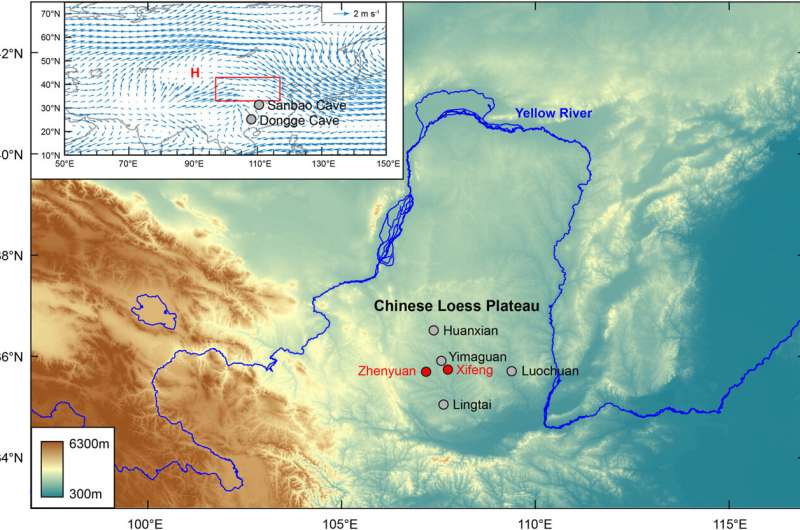
Locations of Xifeng (XF) and Zhenyuan (ZHY) loess profiles on the Chinese Loess Plateau (CLP). Black circles denote four loess profiles investigated in previous studies (Hao et al., 2012; Li et al., 2021; Sun et al., 2010). Red circles represent XF and ZHY loess profiles investigated in this study. Inserted figure in the upper left shows the Dec-Jan-Feb mean surface vector winds based on the NCEP/NCAR Reanalysis data from 1948 to the present at http://psl.noaa.gov/data/gridded/data.ncep.reanalysis.html. H labels the center of Siberian–Mongolian High. The red rectangle refers to the location map. Black circles denote the locations of Sanbao and Dongge caves from the southern China (Cheng et al., 2009, 2016; Wang et al., 2008). Credit: Geophysical Research Letters (2023). DOI: 10.1029/2022GL102404
The East Asian winter monsoon (EAWM) is a major component of the East Asian monsoon circulation, and its intensity is closely linked to the volume of the Northern Hemisphere ice sheets (NHIS) on orbital timescale.
The “sawtooth” pattern of global ice volume shows a gradual build-up of the ice sheets (in ~90,000 years) followed by rapid deglaciation (in ~10,000 years) since the middle Pleistocene transition. However, the loess records of EAWM showed distinct glacial and interglacial modes, with the transitions between them generally being quick.
Recently, researchers led by Associate Professor Li Tao from the Nanjing Institute of Geology and Paleontology of the Chinese Academy of Sciences (NIGPAS) and their collaborators conducted a high-resolution secondary carbonate (microcodium) Sr isotope (87Sr/86Sr) study from two loess-paleosol sequences on the central Chinese Loess Plateau (CLP), and developed an independent chronology framework for assessing the evolution and potential forcing mechanisms of the EAWM during glacial inceptions over the last 550,000 years.
The study was published in Geophysical Research Letters on Feb. 7.
Based on this independent chronology and integrating multi-proxy records, the researchers provide new insights into the dynamics of EAWM during glacial inceptions.
“Our study shows new secondary carbonate (microcodium) 87Sr/86Sr record and integrates multi-proxy records from the central CLP to reinterpret the response of the EAWM to insolation and ice-sheet forcing during glacial inceptions,” said Prof. Li.
2023-02-13 15:00:04
Post from phys.org
The East Asian winter monsoon is a yearly phenomenon that is of great importance for the region. Its evolution and causation have been the subject of considerable research, but its behavior in glacial periods has yet to be thoroughly studied. In a recent study, researchers have investigated the evolution and causation of the East Asian winter monsoon during glacial periods.
By examining glacier deposits and atmospheric deposition records, the researchers were able to identify sea-level changes as one of the primary factors driving the evolution of the East Asian winter monsoon in glacial periods. When sea levels were low, the pressure difference between the Siberian interior and coastal areas increased, resulting in an intensified winter monsoon wind structure. As sea levels rose, this pressure difference decreased, weakening the monsoon wind structure.
The researchers also found that the evolution of the East Asian winter monsoon was affected by a number of other factors, including changes in atmospheric and oceanic circulation patterns. They also identified several distinct periods of monsoon evolution during glacial periods. For example, during the mid-Holocene, there was a period of intensification of the East Asian winter monsoon, followed by a period of weakening.
In conclusion, this study provides valuable insights into the evolution and causes of the East Asian winter monsoon in glacial periods. It highlights the importance of sea-level changes and other factors in influencing the monsoon’s structure and behavior. The findings of this research provide important information for improving our understanding of the processes behind this critical aspect of East Asian climate that affects a vast number of people in the region.
